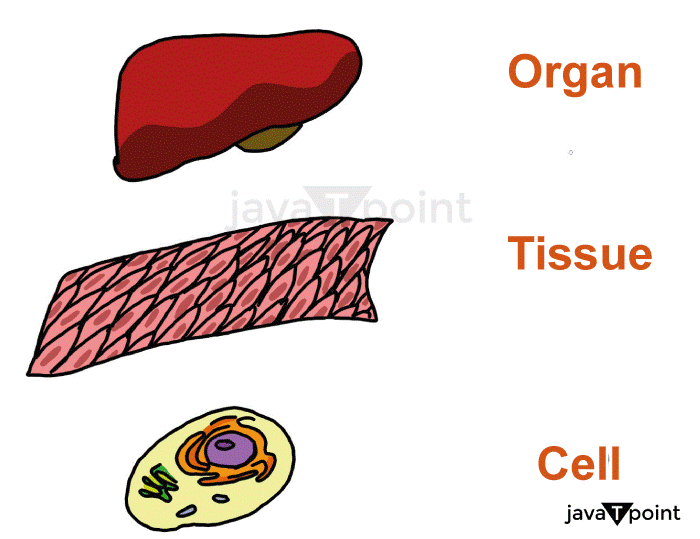Tissue Definition BiologyTissues are collections of cells that cooperate to carry out particular bodily functions. The body's tissues may be divided into four categories: epithelial, connective, muscular, and nerve. The outside of the body is covered in epithelial tissue, which also coats the cavities and internal organs. It performs a protective role by stopping fluid loss and the entry of foreign particles. In organs, including the skin, the lining of the digestive system, and the lungs, epithelial tissue also plays a function in absorption and secretion. 
Structures like bones, cartilage, and tendons are examples of connective tissue, which gives the body stability and structure. A connective tissue's strength and flexibility come from the extracellular matrix, which is made up of proteins and other substances. Body movement is caused by the contraction and relaxation of the cells that make up muscle tissue. Skeletal, smooth, and cardiac muscle tissue are the three different kinds. Smooth muscle regulates uncontrollable processes like digestion and blood vessel constriction, whereas skeletal muscle is in charge of voluntary movement. The heart's cardiac muscle is in charge of distributing blood throughout the body. Neurons, the type of cells that make up nervous tissue, are responsible for the body's signal transmission. It may be found in the brain, spinal cord, and nerves, among other things. Movement, feeling, and perception are only a few bodily functions coordinated and controlled by nervous tissue. These many tissue types are essential to the body's continued general health and functionality. For the diagnosis and treatment of a wide range of illnesses and disorders, including cancer, autoimmune diseases, and musculoskeletal injuries, it is crucial to comprehend the structure and function of tissues. Neurons, the type of cells that make up nervous tissue, are responsible for signal transmission throughout the body. History Of StudyThe study of tissues has a long history, with early anatomists like Hippocrates and Galen delineating the fundamental makeup of bodily tissues. But it wasn't until the invention of the microscope in the 17th century that researchers could examine tissues in great detail. The cell hypothesis, which contends that cells are the fundamental building block of life and that all living things are formed of them, was first out in the 1830s by German anatomist Matthias Schleiden and botanist Theodor Schwann. This hypothesis served as the basis for the study of tissues as cellular clusters that collaborate to carry out certain biological activities. The invention of staining methods in the late 19th century enabled scientists to discern various cell and tissue types under the microscope. As a result, many tissue types, including epithelial, connective, muscular, and neurological tissue, were discovered. Through the 20th century, the study of tissues advanced thanks to the creation of new methods for visualizing tissues and examining their molecular and genetic characteristics. To investigate tissues and comprehend their function in health and illness, researchers today employ a wide range of approaches, from conventional histology to molecular biology and genomics. 
Difference Between Plant And Animal TissuesAnimal and plant tissues differ in a variety of ways, demonstrating how each group of species has uniquely adapted to its environment and way of existence.The existence of a cell wall in plant cells, which offers additional support and protection, is one significant distinction. Animal cells are enclosed by a flexible cell membrane rather than a cell wall, which they lack. In plants, cellulose makes up the cell wall, whereas an animal's cell membrane is made up of a phospholipid bilayer. The existence of chloroplasts in plant cells, which enable them to carry out photosynthesis and manufacture their own food, is another significant distinction. Animal cells don't contain chloroplasts and must obtain their nutrition from outside the cell. Animal cells do not have chloroplasts, which are only found in plants. Animal and plant tissues differ structurally in how their cells are arranged and organized. Plant tissues frequently have stiff and more organized arrangements, which indicates the cell wall's support and structural function. Animal tissues are frequently more adaptive and flexible since they must move around and interact with their environment. Finally, the function and specialization of plant and animal tissues are different. Animal tissues are often specialized for movement, communication, and feeling, whereas plant tissues are frequently specialized for photosynthesis, storage, and support. Overall, the distinctions between plant and animal tissues reflect the particular adaptations and reproduction-related tactics used by each group of species. While there are some parallels between the two, like the existence of cells and the usage of DNA for genetic information, the distinctions in structure and function are substantial and represent the variety of life on Earth. Types Of TissueHuman tissue primarily falls into one of four categories: epithelial tissue, connective tissue, muscular tissue, and nerve tissue.
Each of these many forms of tissue is essential for sustaining the body's general health and functionality. For the diagnosis and treatment of a wide range of illnesses and disorders, from cancer to autoimmune disorders to musculoskeletal injuries, understanding the structure and function of tissues is crucial. Plant tissues are collections of specialized cells that collaborate to carry out particular tasks inside a plant. Plant tissues may be divided into vascular, dermal, and ground tissues.
Functions Of TissuesThe extensive range of duties that tissues carry out in the body are a reflection of their specialisation and organisation to complete certain jobs. A few of the crucial jobs performed by tissues include:
Tissues perform a variety of various tasks that are crucial for preserving the body's overall structure and functionality. Tissues enable the intricate functions of life, such as mobility, communication, digestion, and immunological defence,bycooperating. Diseases/Disorders Related To TissuesThere are several tissue-related illnesses or disorders, ranging in severity from moderate to severe, that can impact different regions of the body. The following list of typical tissue-related illnesses is presented, along with potential treatments for each:
The severity and available therapies for tissue-related disorders might vary substantially. If you are exhibiting symptoms, it's critical to consult a doctor right once and to adhere to the prescribed course of action. Many tissue-related disorders can be effectively treated or managed with the right treatment and care, enhancing the quality of life and lowering the risk of complications.
Next Topictqm-definition
|
 For Videos Join Our Youtube Channel: Join Now
For Videos Join Our Youtube Channel: Join Now
Feedback
- Send your Feedback to [email protected]
Help Others, Please Share










